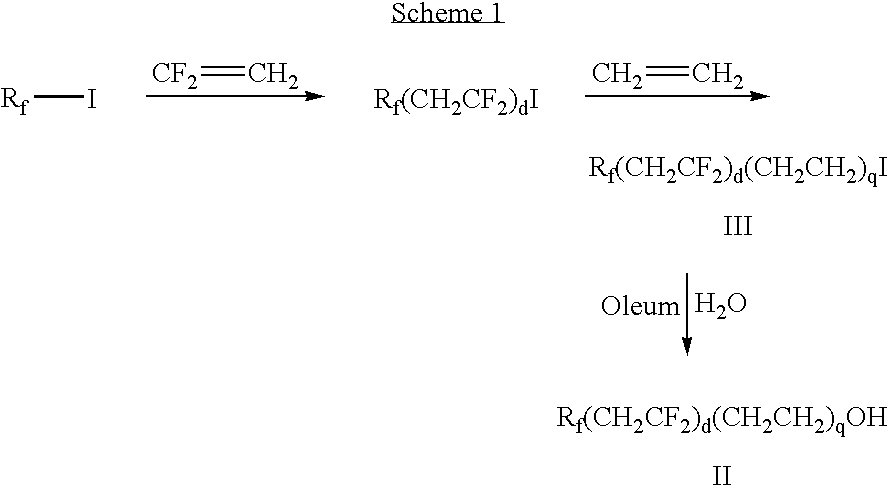Fluorinated polyoxyalkylene glycol diester surfactants
- Summary
- Abstract
- Description
- Claims
- Application Information
AI Technical Summary
Benefits of technology
Problems solved by technology
Method used
Image
Examples
example 1
[0107]A mixture of ethanolamine (13 g, 28 mmol) and ether (30 mL) was cooled to 15° C. Perfluoro-2-methyl-3-oxahexanoyl fluoride (33 g in ether 50 mL) was added dropwise to keep the reaction temperature below 25° C. After the addition, the reaction mixture was stirred at room temperature for one hour. The solid was removed by filtration and the filtrate was washed with hydrochloric acid (0.5N, 30 mL), water (2 times 30 mL), sodium hydrogen carbonate solution (0.5N, 20 mL), water (30 mL), and sodium chloride solution (saturated, 20 mL). It was then concentrated and dried in vacuum over night at room temperature to give N-(perfluoro-2-methyl-3-oxahexanoyl)-2-aminoethanol as a white solid 35 g, yield 95%. mp. 69-72° C. 1H NMR (CDCl3) δ 1.67 (bs, 1H), 3.57 (m, 2H), 3.80 (t, J=5 Hz, 2H), 6.91 (bs,1H).
[0108]A 3-neck flask equipped with an air condenser, stopper and septa kept under nitrogen flush was charged with dry dichloromethane (100 mL). The flask was cooled to 15° C. and poly(ethyle...
example 2
[0109]A similar procedure as described in Example 1 was followed using poly(ethylene glycol) bis(carboxymethyl) ether (Mw ˜1000, average n=19-20, 1.1 g) and C3F7OCFCF3CONH(CH2)2OH (0.903 g) prepared as in Example 1. The reaction mixture was warmed to room temperature and allowed to stir overnight. GC-analysis showed the complete conversion of fluorinated alcohol to the ester. The resulting clear solution was transferred to a separatory funnel and washed with 2% HCl (2×50 mL), saturated NaHCO3 solution (2×50 ML) and brine (1×50 mL). The organic layer was dried (anhydrous MgSO4), concentrated and dried under vacuum to provide fluorinated polyoxyalkylene glycol-diester (1.72 g) as a colorless oil. IR, neat, 3291 cm−1, N—H stretch, 1754 cm−1, C═O stretch of ester, 1716 cm−1 C═O stretch of amide. 1H NMR (CDCl3): δ 4.31 (t, J=4.8 Hz, 4H, OCH2), 4.18 (s, 4H, COCH2O), 3.71 (q, J=5.2 Hz, 4H, N—CH2), 3.64 (bs, polyoxyalkylene glycol OCH2s), 3.0 (bs, 2H, NH): 19F NMR (CDCl3): δ−81.3 (dm, J=147...
example 3
[0110]Ethylene (25 g) was introduced to an autoclave charged with C4F9CH2CF2I (217 g) and d-(+)-limonene (1 g), and the reactor heated at 240° C. for 12 hours. The product was isolated by vacuum distillation to provide C4F9CH2CF2CH2CH2I. Fuming sulfuric acid (70 mL) was added slowly to 50 g of C4F9CH2CF2CH2CH2I and mixture was stirred at 60° C. for 1.5 hours. The reaction was quenched with ice-cold 1.5% by weight Na2SO3 aqueous solution and heated at 95° C. for 0.5 hours. The bottom layer was separated and washed with 10% by weight aqueous sodium acetate and distilled to provide C4F9CH2CF2CH2CH2OH: bp 54-57° C. at 2 mmHg (267 Pa).
[0111]A 4-neck flask with condenser, Dean-Stark trap, magnetic stirrer, thermocouple, and heating mantle was charged with poly(ethylene glycol) bis(carboxymethyl) ether (Mw ˜600, average n=10-11, 10.0 grams), C4F9CH2CF2CH2CH2OH (10.9 grams), p-toluene sulfonic acid (0.22 grams), and toluene (100 grams). After refluxing for 15 hours, GC analysis confirmed fo...
PUM
| Property | Measurement | Unit |
|---|---|---|
| Percent by mass | aaaaa | aaaaa |
| Concentration | aaaaa | aaaaa |
| Surface | aaaaa | aaaaa |
Abstract
Description
Claims
Application Information
 Login to View More
Login to View More - R&D
- Intellectual Property
- Life Sciences
- Materials
- Tech Scout
- Unparalleled Data Quality
- Higher Quality Content
- 60% Fewer Hallucinations
Browse by: Latest US Patents, China's latest patents, Technical Efficacy Thesaurus, Application Domain, Technology Topic, Popular Technical Reports.
© 2025 PatSnap. All rights reserved.Legal|Privacy policy|Modern Slavery Act Transparency Statement|Sitemap|About US| Contact US: help@patsnap.com



